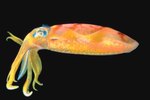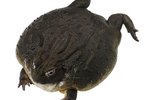The crayfish, also known as a crawfish or a crawdad, can be found all over the world but is primarily located in North America. Specifically, most of the 500 species of crayfish can be found in Kentucky, Louisiana or the Mississippi Basin area. Related to lobsters, the crayfish has a similar appearance and body structure. Attached to the thorax of the crayfish are four pairs of walking legs and one pair of chelipeds. The cheliped is the limb that has a claw, or chelae, attached. Crayfish also have smaller limbs under the tail known as swimmerets.
Walking Legs
The walking legs of the crayfish are known as pereiopods and are attached to the animal's thorax. In addition to their primary function of locomotion, the walking legs of crayfish are used to probe cracks and crevices in rocks for potential food sources. Crayfish are protected by a hard exoskeleton that must be shed during a molting process as they grow. Despite this protection it is common for a crayfish to lose walking legs when attacked by predators; however, the loss is not permanent. Crayfish are able to regenerate lost limbs.
Chelipeds
The most striking feature on a crayfish is the pair of claw-bearing limbs, known as chelipeds, that are attached to the front of the thorax. These limbs are specialized tools crayfish use for cutting up food, capturing prey, attacking one another and as a defense against predators. Crayfish extend the chelipeds in front of the thorax while moving. It is also possible for crayfish to grow an extra claw on the cheliped if certain nerve clusters are damaged.
Swimmerets
In addition to its walking legs and chelipeds the crayfish has five pairs of smaller limbs called swimmerets. The swimmerets are attached to the underside of the abdomen and are used to identify the gender of the crayfish. In male crayfish, the swimmerets closest to the abdomen are larger and harder than the others. That is because the male uses these swimmerets to deposit his sperm into females. Female crayfish have softer, more uniform swimmerets.
Crayfish Behavior
Crayfish are common to freshwater lakes and streams and typically hide underneath rocks and logs during the day. Although they are omnivorous, crayfish are active night hunters. They prey on snails, insect larvae, worms and tadpoles. Crayfish normally use their walking legs to move around at a slow crawl, but they will use their tail to quickly swim backward if they feel threatened. With a life span of approximately two years crayfish must breed quickly and in high volume. Their natural predators include alligators, birds and turtles.
References
Photo Credits
-
Hemera Technologies/AbleStock.com/Getty Images
Writer Bio
Mo Mozuch has been writing professionally since 2005, when he began graduate school at Duquesne University. As a writer and editor he has won several awards, including the Columbia Scholastic Press Award for On-Going News Coverage in 2006. He has worked for College Prowler and been featured on Esquire.com




